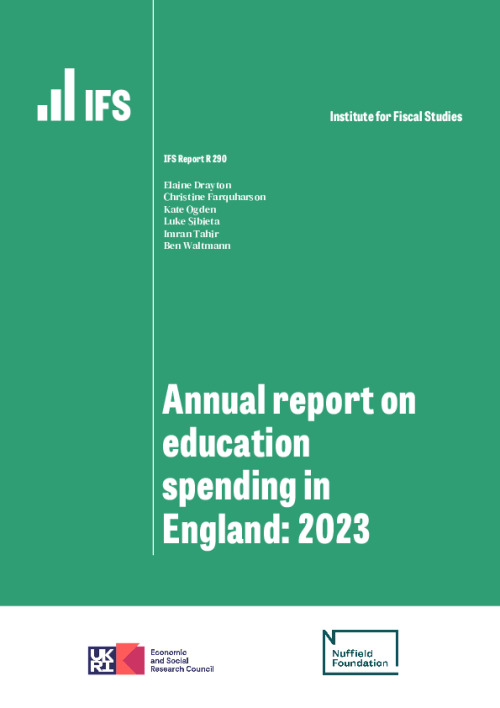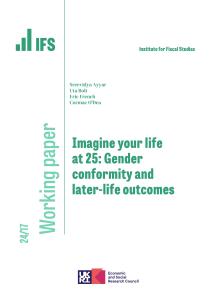Executive summary
This is our sixth annual report on education spending funded by the Nuffield Foundation. It seeks to provide a clear and consistent comparison of the level and changes in spending per student across different stages of education. Our dedicated website further provides easy access to our latest analysis, figures and the underlying methodology.
Following on from cuts to most areas of education spending during the 2010s, the government has provided additional funding at successive spending reviews between 2019 and 2021. However, rising levels of inflation and cost pressures have dampened the effects of extra funding. The government also has high ambitions for education to play a major role in ‘levelling up’ poorer areas of the country. In this year’s annual report, we therefore focus on geographic differences in education spending across each stage of education, as well as the extent to which education spending is targeted at pupils from more disadvantaged backgrounds.
Total spending
1. In 2022–23, total public spending on education in the UK stood at £116 billion (including the cost of issuing student loans and in 2023–24 prices). In real terms, this represents an 8% or £10 billion fall since 2010–11.
2. Education spending has also fallen as a share of national income, from about 5.6% of national income in 2010–11 down to about 4.4% in 2022–23. This is about the same share of national income as in the early 2000s, mid 1980s and late 1960s. There has been no long-run increase in the share of national income devoted to public spending on education, despite large rises in education participation over the long run.
Early years
1. Total spending on early years education and childcare more than quadrupled between 2001–02 and 2018–19, when it reached £6.6 billion. This was largely driven by increases in spending on the free entitlement, while support through the benefit system has fallen since 2009–10. Total spending has fallen since 2018–19 to £5.6 billion, partly impacted by the pandemic and high inflation. This still represents a major increase in resources at a time when other stages of education have been squeezed.
2. From September 2025, all children in working families will get up to 30 hours of funded childcare a week from 9 months old. These new entitlements will mean that free entitlement spending doubles between this year and 2026–27: the largest and fastest expansion on record.
3. The Budget included new money to raise funding rates for existing entitlements. Even so, we estimate that core resources per hour for 3- and 4-year-olds in 2024–25 will be 12% below their level in 2012–13 once providers’ costs are taken into account. The government is instead prioritising younger children: for 2-year-olds, the average (cash-terms) funding rate will reach £8.28 in that year, more than £1 an hour higher in real terms than its previous peak in 2017–18. More important than the specific rates, however, is having a sound process for setting and revising funding rates going forward.
4. The most deprived fifth of local authorities receive hourly resources that are 12% higher than areas in the most affluent fifth, after accounting for higher provider costs in London. This results from funding for deprivation, disability and additional language needs in the Early Years National Funding Formula, as well as the Early Years Pupil Premium and the Disability Access Fund.
5. Except for provisions for disabled children, funding uplifts for additional needs fell between 2017–18 and 2023–24. Despite recent increases, the Early Years Pupil Premium is due to be 2% lower in real terms in 2023–24 than in 2017–18. Core funding for deprived children, which represented an additional 60% of the core funding rate in 2017–18, is worth just 38% in 2023–24. This fall reflects the fact that funding for additional needs is constrained to be 10.5% of total funding, whilst the number of children classified as deprived has increased. Some of the rise in deprivation reflects transitional protection under universal credit. However, a national funding formula where resource per disadvantaged child falls as deprivation rises seems particularly illogical.
Schools
1. School spending per pupil in England fell by 9% in real terms between 2009–10 and 2019–20. This reflects a 1% real-terms increase in total spending on schools, which was more than outweighed by an 11% increase in pupil numbers. The core schools budget is now due to rise from £52.6 billion in 2019–20 to £58.6 billion in 2024–25 (in today’s prices). This funding increase will reverse past cuts and we estimate that school spending per pupil in 2024 will return to 2010 levels in real terms based on standard measures of economy-wide inflation (the GDP deflator).
2. The costs faced by schools – such as teacher and support staff salaries – are growing faster than economy-wide inflation. We estimate that schools’ costs will rise by 7% in 2023–24. This reflects the 6.5% pay offer to teachers and an 8% salary rise for support staff. In 2024–25, we estimate that schools’ costs will grow by 4%, which is just about matched by 4% growth in total funding. After accounting for growth in schools’ costs, we estimate that the purchasing power of school budgets in 2024 will still be about 4% lower than in 2010. The recently announced 10% increase in the National Living Wage could push up school costs further, as local government employers seek to maintain small wage differentials over the National Living Wage.
3. Secondary school spending per pupil in England in 2023–24 is due to be about £6,900, which is 10% higher than in primary schools (£6,300). This is down from a difference of about 30% in the 2000s and over 50% during the early 1990s. This represents a very significant reduction in the secondary:primary funding ratio over time.
4. School spending per pupil is about 21% higher amongst the most deprived group of schools than for the least deprived group, even after accounting for differences in costs across areas. However, this funding advantage is down from 31% in 2010 due to larger spending cuts for more deprived schools. Between 2010 and 2021, the most deprived secondary schools saw real-terms cuts of 12% compared with 5% for the least deprived ones.
5. A range of factors explain the larger cuts for more deprived schools. First, the Pupil Premium has not kept pace with overall inflation. Second, the introduction of statutory minimum funding levels in 2020 disproportionately benefited less deprived schools, and reduced the share of total funding focused on more deprived schools. Third, funding factors for deprivation in local authority formulae have reduced in real terms over time, mostly reflecting decisions to reduce deprivation funding in the national formula in 2018. Some of this shift was a deliberate decision to focus more on funding for schools with low prior attainment. This will have spread disadvantage funding more widely. However, it will only have partially compensated the most deprived schools for reductions in deprivation funding over time.
6. The pupil population is expected to decline by 600,000 or 8% between 2024–25 and 2030–31, with a 400,000 reduction in primary school pupil numbers and a 200,000 reduction in secondary school pupil numbers. This would reverse almost all of the increase in the pupil population since 2010–11 and create less demand for school places. However, declining pupil numbers will only reduce spending needs if schools are able to shrink their costs and staff numbers in equal measure.
Further education and skills
1. In the 2023–24 academic year, we estimate that spending per student aged 16–18 in further education (FE) colleges will be £7,100, compared with £5,800 in school sixth forms and £5,400 in sixth-form colleges. Higher funding for FE colleges reflects extra funding for costly technical programmes and for students from more deprived areas.
2. Between 2010–11 and 2019–20 financial years, spending per student aged 16–18 fell in real terms by 14% in colleges and 28% in school sixth forms. For colleges, this left spending per student at around its level in 2004–05, while spending per student in sixth forms was lower than at any point since at least 2002.
3. In the 2021 Spending Review, the government announced £1.6 billion in extra funding for colleges and sixth forms by 2024–25. Yet even with the additional funding, college spending per student in 2024–25 will still be about 10% below 2010–11 levels, and school sixth-form spending about 23% lower than in 2010–11.
4. The government announced extra funding in July and October 2023 to enable colleges to afford higher staff pay rises and to increase funding rates for GCSE retakes. However, none of this was new funding. It all came from existing plans. Student numbers have increased by less than expected and the government could thus increase funding rates by more than planned.
5. The main driver of slower growth in student numbers is a 13% decline in the number of 18-year-olds in further education between 2019 and 2022. This reflects falling levels of participation in education and training amongst 18-year-olds, which has fallen from 73% in 2015 to 70% in 2020 and to 66% in 2022. There has been a gradual rise in the share of 18-year-olds in employment (up from 14% in 2014 to 19% in 2022). The share of 18-year-olds who are not in education, employment or training (NEET) was at 16% in 2022, near equal to the share last seen in the Great Recession of the late 2000s.
6. The distribution of funding across areas is highly shaped by the share of students in (more highly funded) FE colleges, which leads to higher levels of spending per student in more disadvantaged areas and in Northern regions of England, with mostly lower spending levels in London. As a result, spending per student is about 9% higher in the most deprived areas than in the least in 2023–24, up from about 4–5% in 2013–14. This increase reflects the smaller cuts for FE colleges and greater funding for students in disadvantaged areas over time.
7. Total spending on adult skills is set to increase by 14% in real terms between 2019– 20 and 2024–25. However, this only reverses a fraction of past cuts: total adult skills spending in 2024–25 will still be 23% below 2009–10 levels. Spending on classroom-based adult education has fallen especially sharply, driven by falling learner numbers and real-terms cuts in funding rates, and will still be over 40% below 2009–10 levels in 2024–25 even with the additional funding.
8. Following on from big increases between 2010 and 2015, the total number of adult apprentices (aged 19 or over) has declined by 16% since 2016–17 and the introduction of the apprenticeship levy. However, the number of higher apprentices, including degree apprentices, has trebled in the same period.
Higher education
1. Up-front spending on teaching resources per higher education student has continued to decline steadily, standing at £9,600 per year for the 2023–24 university entry cohort. This is around £2,100 or 18% lower in real terms than in 2012–13, largely because the cap on tuition fees is now 24% lower in real terms than it was in 2012–13. Teaching resources are now only slightly higher in real terms than they were in 2011–12 (£9,400) before the substantial increase in tuition fees.
2. The nominal freeze in the level of fees is set to continue for another year, adding financial pressure on universities. At the same time, official forecasts for domestic student numbers have been revised down substantially, with the number of undergraduate student entrants now expected to increase by 7% between 2021 and 2026. In more welcome developments for higher education providers, international student recruitment has been strong, and the finances of the main university pension scheme (USS) have improved markedly on the back of higher long-term interest rates.
3. For current students, higher-than-expected inflation has continued to erode the real value of maintenance loans. Students in 2023–24 will be entitled to borrow 11% less towards their living costs than they were in 2020–21, a cut equivalent to £107 a month for the poorest students. Without a change in policy, living cost support for future students will be permanently lower, causing hardship for some.
4. On top of this, parental earnings thresholds governing maintenance loan eligibility have been frozen since 2008. As a consequence, maintenance support for students from families with middling earnings has been cut even more severely. A student with parental earnings of £62,000 is entitled to £4,700 this academic year, but would have received £2,500 (52%) more in real terms in 2016–17 if their parents earned the same relative to average earnings.
5. Unlike for other stages of education, the distribution of higher education spending across local areas differs substantially depending on whether students’ local areas of origin or their areas of residence during term time are considered. By the area that students come from, spending per young person is highest in London (£15,800) and lowest in Northamptonshire (£5,800) and Blackpool (£6,250). This largely reflects differences in areas’ university participation rates, with students from more advantaged backgrounds more likely to attend higher education and benefit from spending directly.
6. Higher education spending also has wider economic impacts on the areas in which people study. On this measure, per-capita higher education spending is highest in university towns, with by far the highest spending in Canterbury (£2,300) followed by Bath (£1,380) and Brighton (£1,280). In contrast, around a third of all travel-to-work areas in England do not have a higher education provider and therefore do not benefit directly from public spending on higher education at all. A handful of local areas – notably Oxford and Cambridge – also benefit substantially from public research funding for universities, and reap more rewards from the innovation that comes alongside.















